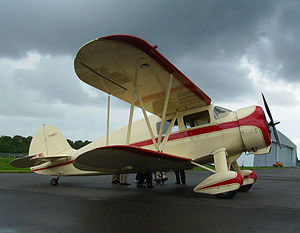Waco Standard Cabin series
| Waco Standard Cabin series | |
|---|---|
 |
|
| 1937 Waco VKS-7 late Standard Cabin biplane (C-FLWL) at the Canada Aviation and Space Museum at Rockcliffe, ON. | |
| Role | 4-5-seat cabin biplane |
| National origin | United States |
| Manufacturer | Waco Aircraft Company |
| Introduction | 1931 |
| Status | Several still airworthy in 2009 |
The Waco Standard Cabin series is a range of American single-engine 4-5 seat fabric covered cabin biplanes produced by the Waco Aircraft Company beginning in 1931 with the QDC and continuing until 1942 when production ended for the VKS-7F. They were used as light passenger and utility transports, navigational trainers, bushplanes and briefly as maritime reconnaissance aircraft during World War 2.
All of the Waco Standard Cabins were powered by cowled radial engines and Waco tried to accommodate their customers preferences for many of the more common commercially available engines of the period, hence the profusion of designations, as the first letter indicates the engine installed. Individual models were each certified with various available engines but not all variations found customers.
Fuselage structure was typical for the period, being welded chrome-moly tubing with light wood strips to fair the shape in and covered with fabric. Wings were built around two solid spruce spars with the airfoil formed from trussed ribs made from plywood and spruce. The leading edge was covered in aluminum sheeting and the whole assembly covered in fabric. Ailerons were interconnected with a strut mounted to the trailing edge and on some versions were sheeted with ribbed aluminum. Most models were not fitted with flaps - the VKS-7F, built for the Civilian Pilot Training Program (CPTP) being the exception. It was fitted with split flaps only on the undersides of the upper wings and at mid chord, inboard and just ahead of the ailerons. Wing bracing was with a canted N strut joining upper and lower wings, assisted by a single strut bracing the lower wing to the upper fuselage longeron, there being no bracing wires. Elevators and rudder were built up from welded steel tubing braced with wire cables, and both could be trimmed, the elevators in flight and the rudder with a ground adjustable tab. Normally the main undercarriage was made up of a pair of vees, sprung with oleo/spring struts and provided with brakes as standard equipment, and a free-castoring tailwheel sprung with triangulated shock cords. was fitted to most aircraft, although a small number for Brazil were fitted with a tail skid. Floats were also offered as an option, starting with the UIC which had Edo P-3300 floats. Later types (including the UKC, YKC and CJC) were offered with Edo 38-3430 floats.
...
Wikipedia
